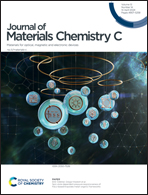Magnetic properties of CrX3 (X = Cl, Br, I) monolayers in excited states†
Abstract
The presence of intrinsic ferromagnetism in a new class of magnetic semiconductors CrX3 (X = Cl, Br, I) in a reduced dimension is associated with magnetic anisotropy energy (MAE). MAE is relevant for the magnetic order of CrX3. The control of magnetism in such 2D materials through external stimuli is gaining importance in view of potential technological applications. Here, we use all-electron density functional theory to investigate the magnetism of monolayers of chromium halides in excited states using a cluster model. We study the magnetization reversal barrier for two types of electronic singly excited states: (a) spin-preserving transitions, and (b) spin-flip transitions. While all the three halides show enhancement of MAE in excited states, the MAEs are significant for CrI3 due to the large spin–orbit coupling in the iodines. The changes in the MAE in the excited state are influenced by the local charge distribution surrounding the iodine atoms. Using a model system, we also show that the MAE in chromium tri-iodides is strongly influenced by the charge transfer to the iodines in an excited state. Thus, controlling the charge transfer to the iodines can potentially be used to control the magnetization reversal barrier.



 Please wait while we load your content...
Please wait while we load your content...
